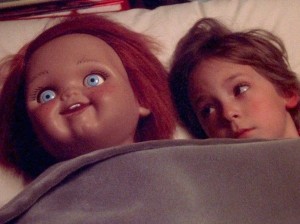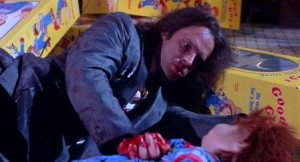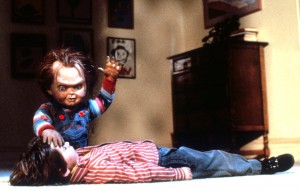 Child’s Play
Child’s Play
Directed: Tom Holland
Starring: Catherine Hicks, Chris Sarandon, Alex Vincent, and Brad Dourif
82 mins, R
Child’s Play isn’t about Christmas, but it is a wintry movie about the perils of gift-giving, and it was on constant television rotation during the holidays when I was younger. The movie is therefore inextricably linked to Christmas and New Years in my mind: a terrible-wonderful, too-brief, plastic killing spree. With the franchise four sequels deep and with two comic book spinoffs, I’m sure you’ve heard of Chucky the murder doll, but have you seen the original fim? I make no assumptions — some of you haven’t even seen Gremlins.
Let me share with you an interesting fact about Child’s Play. It was initially reviewed quite favourably. Critics called it breezy, original, topical, and fun, but over time its Rotten Tomatos score has sunk lower and lower. I mean, it’s not novel anymore, and the special effects are… late eighties special effects. Today, Child’s Play the franchise is horror-comedy; a good Halloween  costume and a less-good Christmas present. But when it was first released in 1988, there was no doubt that Child’s Play was horror (with a little humour thrown, too, of course) — so disturbing, in fact, that it was variously boycotted and blamed for inspiring multiple murders and the minor criminal activities of children everywhere. In 1988, Child’s Play was hot, and it scared the shit out of parents.
costume and a less-good Christmas present. But when it was first released in 1988, there was no doubt that Child’s Play was horror (with a little humour thrown, too, of course) — so disturbing, in fact, that it was variously boycotted and blamed for inspiring multiple murders and the minor criminal activities of children everywhere. In 1988, Child’s Play was hot, and it scared the shit out of parents.
Serial killer and petty criminal Charles Lee Ray (Brad Dourif) is shot by police and left to die by his accomplice. He runs, desperate to the last, but finally dies in a toy store, with Detective Mike Norris still chasing him. It’s a fun scene that Dourif infuses with real desperation. Charles Lee Ray careens through the store, shouting, vowing revenge, and always with an eye on escape. “I’m dying,” he says with a sneer, like it’s the worst inconvenience. “I have to find someone.” He finds “someone” in a talking, blinking Good Guy Doll — using a (racist!) spell, he transfers his consciousness and physical strength into the doll. This being 2014, you already know that Charles becomes Chucky, but in 1988, the film held this out as just one possibility. The other is that the recipient of the doll, six-year-old Andy, is experiencing episodes of psychotic dissociation, and projecting his worst impulses on the doll. That is, he’s pretending the doll is evil so that he can get away clean.
From Charles Lee Ray we quickly move to single mom Karen Barclay and son Andy. It’s Andy’s birthday and while Karen obviously loves him dearly, she is struggling to provide for him the way she would like. He is obsessed with Good Guys: the cartoon, the toys, the pyjamas, the snowsuit, and now, the new doll that promises to be Andy’s “friend to the end.” Karen proudly presents him with Good Guys tool set and some non-Good Guys clothes, but Andy’s disappointment is obvious — he wants that doll. At work later that day, Karen’s co-worker and friend drags her away from her jewelry counter to buy a stolen Good Guy from a homeless man selling things in the alley. Success! Andy is elated and Karen is both releived and proud. And the doll, of course, was scavenged from that fatal toy store scene. It quickly becomes obvious that something is not quite right with “Chucky.”
The single mom was a much talked about figure in the 80s and 90s ( and still is, because when will we get tired of shaming women? A quarter to never, is my guess). When sitcom character Murphy Brown chose to have a baby as a single woman, it sparked a national chat show armagedon. Murphy Brown was a highly successful, independent career woman, but but- an unwed mother! The controversy that followed was typical of the discussions around motherhood in the 80s and 90s, especially oh so evil single motherhood. So much worse if she’s single (or a widow, it’s not clear here) and struggling like Karen, just barely getting by on a department store job, and spending all of her spare cash on frivolous things like toys for her son. Karen is plagued at work by an abusive boss and later in the film, by doubtful cops who just want to protect the little lady. She is also, despite the warm and loving relationship that she and Andy share, plagued by worry. Is she a good mother? Is she home enough? Is she doing right by Andy?
 It’s these worries that fuel Child’s Play; that make the idea of a doll come to life so potent. Dolls are an early object of affection for many children: one of the first after their parents. As children explore their worlds, their parents become a smaller part of it — still immensely significant, but joined by friends, classmates, and toys imbued with imaginary personalities. And while the secret life of dolls has long fascinated us, combined with the spectre of a working mother abandoning her children to their care, well. Andy finds Good Guys compelling because the cartoon characters and dolls promise compionship and loyalty. Charles Lee Ray understands this: his first words to Andy after being pulled out of the box are, “I’m Chucky, and I’ll be your friend to the end.” He’s quick to bring Andy into his confidence and to establish a world of their own. Of course, he plays along so that he can eventually escape and get his revenge, but his actions realize two primal fears: that of a child being turned away from his parent, and that of there being something more to the objects you’ve brought into your home. What if dolls do come to life at night? What are they telling your children?
It’s these worries that fuel Child’s Play; that make the idea of a doll come to life so potent. Dolls are an early object of affection for many children: one of the first after their parents. As children explore their worlds, their parents become a smaller part of it — still immensely significant, but joined by friends, classmates, and toys imbued with imaginary personalities. And while the secret life of dolls has long fascinated us, combined with the spectre of a working mother abandoning her children to their care, well. Andy finds Good Guys compelling because the cartoon characters and dolls promise compionship and loyalty. Charles Lee Ray understands this: his first words to Andy after being pulled out of the box are, “I’m Chucky, and I’ll be your friend to the end.” He’s quick to bring Andy into his confidence and to establish a world of their own. Of course, he plays along so that he can eventually escape and get his revenge, but his actions realize two primal fears: that of a child being turned away from his parent, and that of there being something more to the objects you’ve brought into your home. What if dolls do come to life at night? What are they telling your children?
 So, plot-wise, Child’s Play goes about how you would expect. Andy becomes increasingly alienated from those around him and is even blamed for the death of Karen’s friend. Chucky, nee Charles Lee Ray, has a violent, misogynistic temper and his attempt to keep his cover doesn’t go so well. Within days of his being gifted to Andy, he’s pushed a woman out of a window (remember, he has all the physical strength of his former human body), framed Andy for it, fought with Karen, and been let loose on the city to track down his former accomplice. During a confrontation with Dr. John, Chucky’s “voodoo teacher” (ra-ra-ra-raciiiist!), he learns that the longer he possesses the doll, the more human the doll becomes. That is, if he doesn’t jump bodies to the first person he revealed his possession to, the Good Guy doll body will become a real boy of sorts, living, breathing, and bleeding, but still plastic. It’s a strange, gruesome fate, one that Chucky quite naturally wants to avoid — better to possess Andy and grow up again. He stabs a voodoo doll of Dr. John (ugh, so racist), fatally wounding him, and leaves to find Andy. Karen and her new ally, the formerly doubtful Detective Norris arrive in time for Dr. John’s last words: Chucky’s heart is already human, and therefore vulnerable. We’re in the territory of both fairy tales and demonic possession with this: be careful what you wish for; be careful who you gift to.
So, plot-wise, Child’s Play goes about how you would expect. Andy becomes increasingly alienated from those around him and is even blamed for the death of Karen’s friend. Chucky, nee Charles Lee Ray, has a violent, misogynistic temper and his attempt to keep his cover doesn’t go so well. Within days of his being gifted to Andy, he’s pushed a woman out of a window (remember, he has all the physical strength of his former human body), framed Andy for it, fought with Karen, and been let loose on the city to track down his former accomplice. During a confrontation with Dr. John, Chucky’s “voodoo teacher” (ra-ra-ra-raciiiist!), he learns that the longer he possesses the doll, the more human the doll becomes. That is, if he doesn’t jump bodies to the first person he revealed his possession to, the Good Guy doll body will become a real boy of sorts, living, breathing, and bleeding, but still plastic. It’s a strange, gruesome fate, one that Chucky quite naturally wants to avoid — better to possess Andy and grow up again. He stabs a voodoo doll of Dr. John (ugh, so racist), fatally wounding him, and leaves to find Andy. Karen and her new ally, the formerly doubtful Detective Norris arrive in time for Dr. John’s last words: Chucky’s heart is already human, and therefore vulnerable. We’re in the territory of both fairy tales and demonic possession with this: be careful what you wish for; be careful who you gift to.
 Chucky tracks down Andy, still locked up for Chucky’s latest murder, and they fight. Chucky is of course much stronger physically, and his personality is fierce. He tries to lean on the relationship he built with Andy — he may have done Andy wrong, but aren’t they friends to the end? As in most fairytales, though, Andy has already seen through Chucky’s lies. His mother and Detective Norris eventually swoop in to kill Chucky and save the day. Andy and Karen lovingly reunite, and there’s a suggestion of a possible relationship between Karen and Norris, as he looks on at mother and child. This the is restorative justice of modern fairy tales and of many horror films: the alien element, the killer doll that came between them, has been removed from the home, and there’s hope that the family of two will soon become a tidy, heteropatriarchal family of three. Chucky may come back for the sequels, but these three won’t — they’re safe.
Chucky tracks down Andy, still locked up for Chucky’s latest murder, and they fight. Chucky is of course much stronger physically, and his personality is fierce. He tries to lean on the relationship he built with Andy — he may have done Andy wrong, but aren’t they friends to the end? As in most fairytales, though, Andy has already seen through Chucky’s lies. His mother and Detective Norris eventually swoop in to kill Chucky and save the day. Andy and Karen lovingly reunite, and there’s a suggestion of a possible relationship between Karen and Norris, as he looks on at mother and child. This the is restorative justice of modern fairy tales and of many horror films: the alien element, the killer doll that came between them, has been removed from the home, and there’s hope that the family of two will soon become a tidy, heteropatriarchal family of three. Chucky may come back for the sequels, but these three won’t — they’re safe.
Child’s Play isn’t a great movie. It’s quality is average, its politics outdated and it’s depiction of “voodoo,” lazily racist. But it is an interesting movie: a time capsule about giving, having, and loving. It arrived smack in the middle of the direct-to-kids advertisting nadir, when cartoons were being created to sell toys, and when toys became personalized and individualized to the point of coming with unique histories. The Good Guy cartoon and dolls were inspired by Cabbage Patch dolls and the Care Bears. It suggests that when the consumer impulse and the mother instinct are fused, we are vulnerable. That, I think, is basically bullshit insofar as it works to shame working mothers. But there is something to its worries compulsory consumption and about the not-so-silent part that our things play in our lives.

